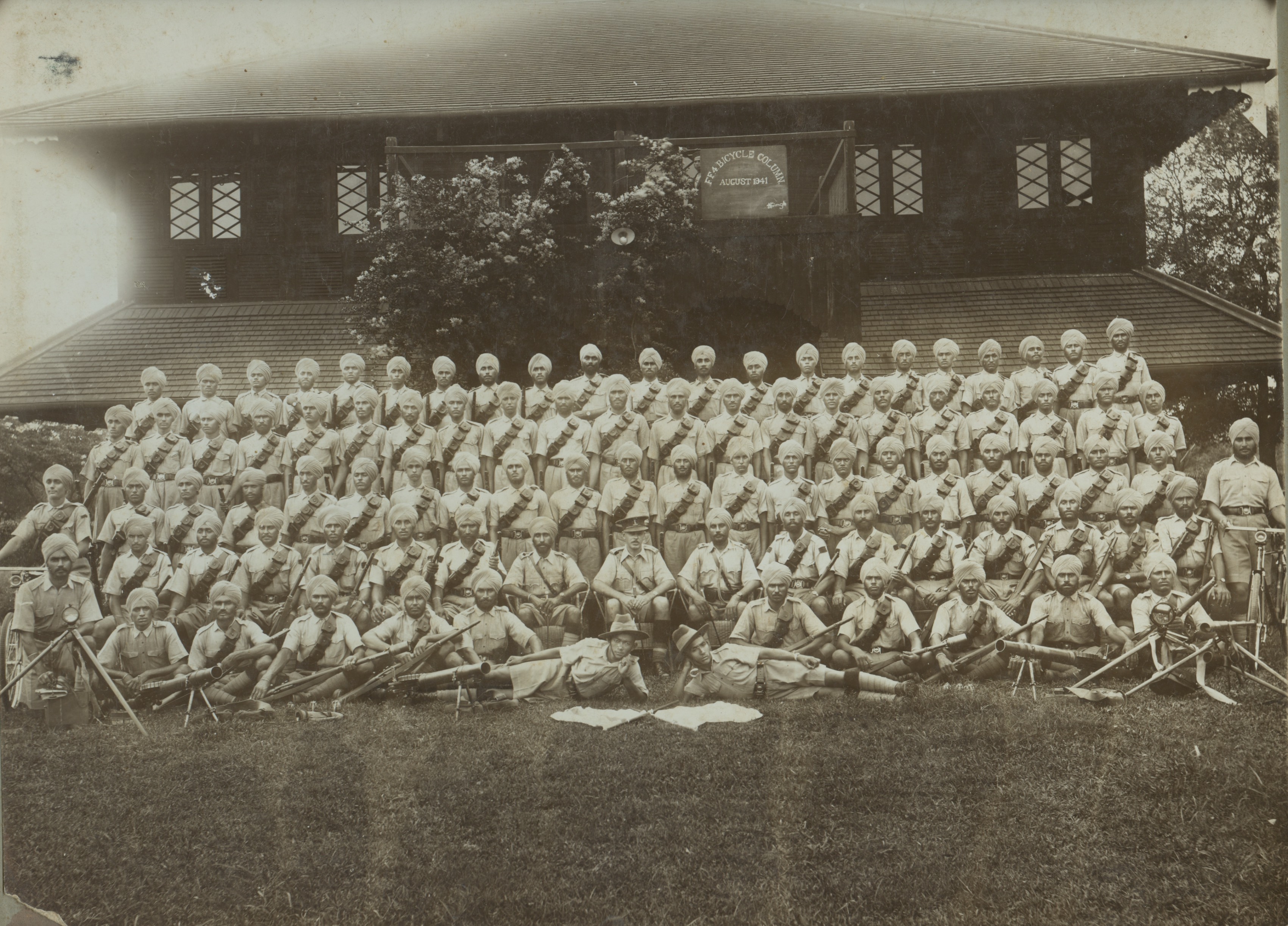No. 4 Infantry Column (Bicycle), F.F.4 – August 1941
Photograph of No.4 Bicycle Infantry Column, forming part of the Burma Frontier Force mobile detachment known as F.F.4, August 1941. The location is most likely Pyawbwe, the depot for the Reserve Battalion, Burma Frontier Force and the location where F.F.4 began forming in August 1941. (Michael Turner)
One of three bicycle infantry columns forming part of F.F.4, No.4 Bicycle Column, was commanded by 2nd Lieutenant Ian Henry Turner (seated front centre).[1] The raising of the mobile detachment F.F.4 of the Burma Frontier Force was authorised in August 1941 and formation began during September. The signboard in the photograph gives the date as August 1941 and it may therefore be assumed that it was taken on or shortly after the column was raised. The first of the columns for F.F.4 were raised from the Reserve Battalion, Burma Frontier Force, at the time based at Pyawbwe.
The column formed one of four which made up F.F.4, which was composed of a small headquarters section, one motorised infantry company (column) and three bicycle-mounted infantry columns. When fully formed, F.F.4 was organised as follows:
- Headquarters Section: C.O. Major N.T. Loring; Adjutant, 2nd Lt. L.G. Gaudie
- No. 1 Infantry Company/Column (Motorised) : Kachins commanded by 2nd. Lt. G.H.C. Peters
- No. 2 Infantry Company/Column (Bicycle) : Punjabi Mussalmen commanded by 2nd Lt. Robert Cecil Fullarton
- No. 3 Infantry Company/Column (Bicycle) : Punjabi Mussalmen commanded by 2nd Lt. I.C.G. Scott
- No. 4 Infantry Company/Column (Bicycle) : Sikhs commanded by 2nd Lt. I.H. Turner
- Mortar Platoon and the Wireless Section.
Each column was the equivalent of a normal rifle company in size, but without the support weapons that a regular infantry company would expect to field. Each column had only a single out-dated Lewis gun, although the column depicted here has three. It is interesting to note also: the grenade discharger cups fitted to two of the rifles; the signal lamps and telescopes used for communication; signal flags which presumably provided a back-up to the signal lamps. Additional weapons in the form of a single Bren gun, five Thompson sub-machine guns and one mortar per column were not issued until the war with Japan began.
Having infantry companies dependent on bicycles for mobility was something of an experiment. Few men knew how to ride them and training in this basic skill did not begin until F.F.4 moved to Loilem in the Shan States during September 1941. A camp was established there from which in October 1941, 2nd Lieutenant Scott was sent to reconnoitre F.F.4's planned operational area in the Mongpan-Mongton area. He quickly discovered that the terrain in this area was not the most suitable for cyclists.
I am grateful to Michael Turner and family for granting permission to reproduce the photograph here.
For a full history of F.F.4, click here.
23 August 2019
[1] Ian Henry Turner, born in Australia, 22nd May 1909. Emergency Commission to the General List as 2nd Lt. (189635), 28th April 1941. Served with the Reserve Battalion, Burma Frontier Force; assisted Lt. I.C.G. Scott with infantry training, May? 1941 to August 1941. Column Commander, No. 4 Column, F.F.4, Burma Frontier Force, September 1941 to March 1942. Temporary Captain (war substantive Lieutenant), 14th March 1942. Evacuated sick, end March/early April 1942. Temporary Captain from 28th August 1943. As war substantive Major, relinquished commission and granted the honorary rank of Lt. Colonel, 11th October 1946 (British Army List October 1945; Burma Defence Services List July 1941; Burma Army List 1943; London Gazette; Private Papers of Lt. Col. I.C.G. Scott (IWM)).
